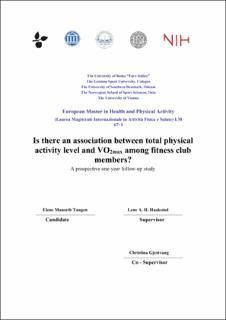Is there an association between total physical activity level and VO2max among fitness club members?: A prospective one-year follow-up study
Abstract
BACKGROUND: Since Cardiorespiratory fitness (CRF) is an important predictor for allcause mortality, it is vital to know if meeting the global physical activity (PA) recommendations of 150 minutes of moderate-to-vigorous PA (MVPA) weekly is associated with higher levels of the gold standard measure of CRF: Maximal oxygen uptake (VO2max). The majority of former research has investigated this association in the general adult population, and has used self-reporting of PA level. Self-reported PA increases the chance of over-reporting PA level, which device-measured PA does not. To this date, no studies have investigated the association between device-measured PA and VO2max in a fitness club setting. Thus, the aims of this present study were to investigate if there was an association between device-measured PA and VO2max, and if a non-exercise model could predict VO2max among untrained adults at membership start-up and after one year of fitness club membership.
METHOD: This master thesis was part of the research project: “Fitness clubs – a venue for public health?” a longitudinal prospective study. At membership start-up, 125 untrained new fitness club members were recruited for the study. PA level was measured with ActiGraph GT1M for seven constructive days, and VO2max was measured with a cardiopulmonary exercise test using the stepwise modified Balke protocol at membership start-up (n = 125) and at one-year follow-up (n = 61). A Pearson correlation was assessed for minutes in MVPA and
VO2max, as well as total counts per minute (cpm) and VO2max. To assess for potential covariates, and to develop a non-exercise model, a multivariable regression analysis including six factors: minutes in MVPA, total cpm, body mass index (BMI), fat mass%, age and gender with VO2max (mL·kg−1·min−1), as a dependent factor, was calculated at both time points.
RESULTS: At membership start up, time spent in MVPA and total cpm was significantly associated with VO2max in both genders (bivariate correlation coefficient r=.259, p=.002 and r=.275, p=.001, respectively), but not at follow-up (r=.123, p=.173 and r=.198, p=.063). When adjusting for covariates (gender, fat mass%, age and BMI), no association was found between MVPA and cpm with VO2max at membership start-up (p=.83 and p=.08) or at follow-up (p=.527 and p=.164), respectively. The non-exercise model explained 69% and 58.8% of
variance in measured VO2max (mL·kg−1·min−1) at membership start-up and at follow-up (p<.001). Age, gender and fat mass% were the strongest predictors explaining VO2max.
CONCLUSION: Device-measured PA was significantly associated with VO2max at membership start-up, but not at 1-year follow-up. The non-exercise model may be a feasible tool for rough estimate of VO2max among healthy and untrained fitness club members.
Description
Masteroppgave - Norges idrettshøgskole, 2020
